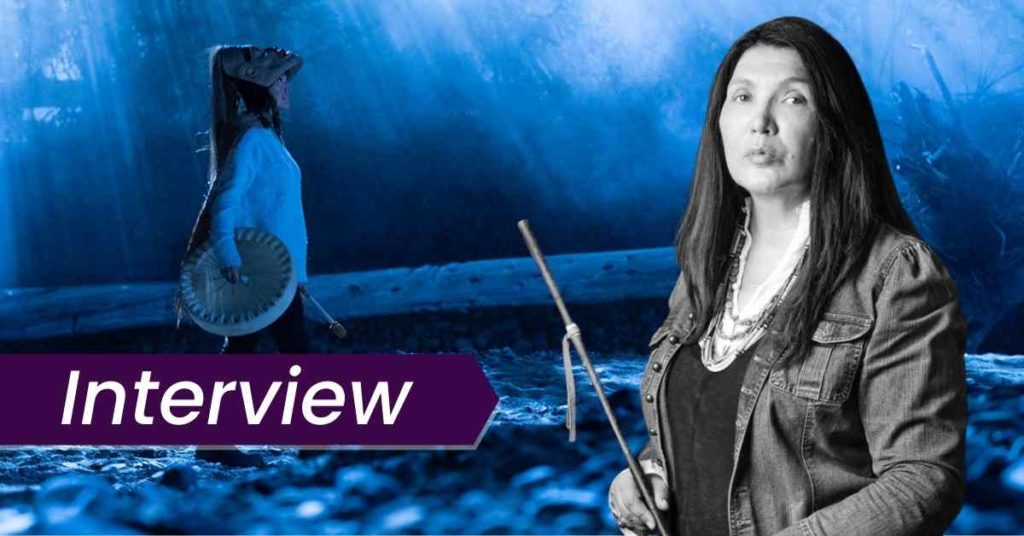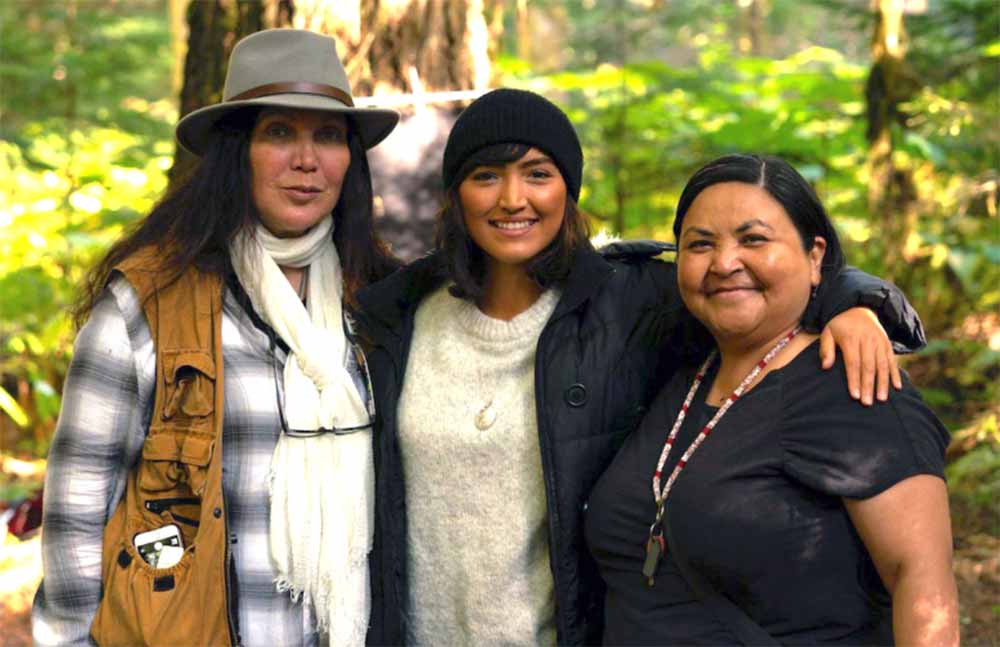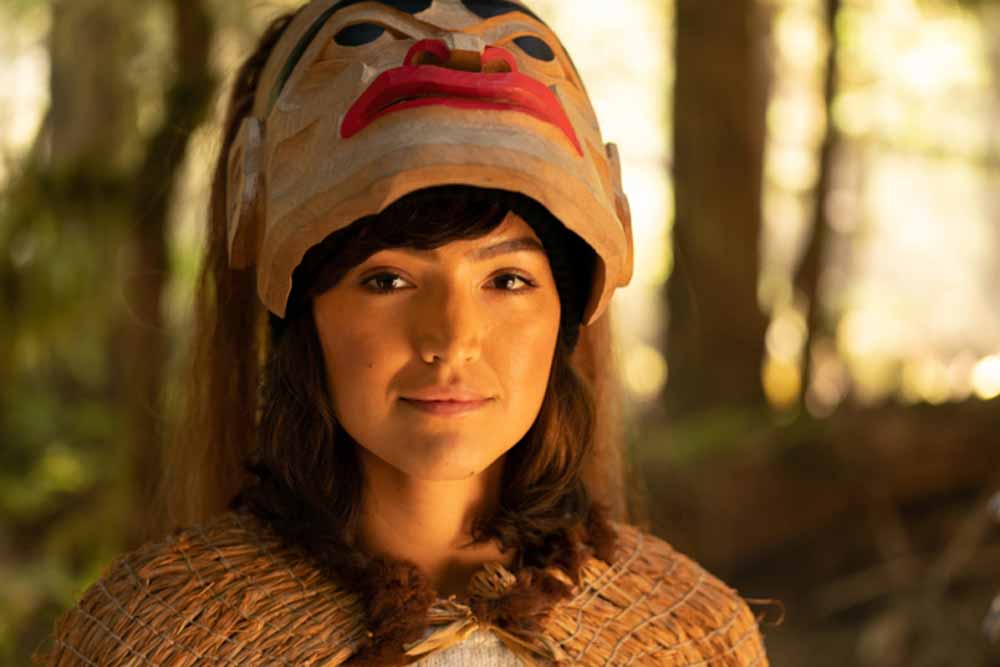Writer-director Loretta Todd discusses the 20 year journey to making Monkey Beach. Today is the last day Monkey Beach is streaming worldwide at the American Indian Film Festival, at a pay what you can rate.

Discover one film you didn’t know you needed:
Not in the zeitgeist. Not pushed by streamers.
But still easy to find — and worth sitting with.
And a guide to help you do just that.
Loretta Sarah Todd has been making films for almost 30 years, but Monkey Beach marks her first narrative feature — one of two adaptations of Eden Robinson novels to be released this year. It’s took taken 20 years to get the film made in part because Todd insisted on shooting the film where the story is set, in the remote Kitimat, BC — not just because the land is so integral to Robinson’s story, but also so she could give back to the community. Her refusal to compromise on this pays dividends in the film, but it meant facing many funding roadblocks, which Todd is frank about. One can only hope that future Indigenous productions of this scale won’t face the same degree of challenges.
Monkey Beach tells the story of Lisa (Grace Dove), a young Haisla woman who gets visions of loved ones dying before it happens. Ever since she was a child (her child counterpart is played by Zoey Snow), she’s been plagued by one vision, in particular, of her younger brother, Jimmy (Joel Oulette, and the younger Oliver Tru Sison), who is also a high level competitive swimmer, drowning. Having watched so many loved ones die and been powerless to do anything about it, she left home in, Kitimat, for Vancouver to drink and party and try to forget. When the film begins, Lisa returns home after two years away, to rekindle her relationships with her family and friends — and talk to dead loved ones, another gift. When Jimmy goes missing on a fishing trip, she becomes obsessed with saving him, but what that ends up meaning shifts as the film progresses, and as Lisa comes to terms with her gifts and her grief.
Peppered throughout the film are flashbacks to Lisa’s childhood, where we get to know her Uncle Mick (the amazing Adam Beach) and her grandmother, Ma-ma-oo (Tina Lameman), both of whom were incredibly influential on her identity as an Indigenous woman and her politics. Just like Robinson’s novel, Todd’s film treats theat past, present, and future as inherently intertwined, and the dead as always nearby, if invisible to most people. Robinson’s story of grief and loss and finding a way to make peace with it is what drew Todd to make the film and persevere through all these years.

Todd is Cree-Métis, and her filmmaking practice takes inspiration from the oral tradition, tying stories and words to sensory experiences. That’s evident in the filmmaking of Monkey Beach which is a visually sumptuous film made on a low budget, that will make you want to buy a ticket to BC as soon as it’s safe to do so. The way Todd visualises’s images of Lisa’s visions and flashbacks are visceral, and inherently tied to how you remember and think about the film. Although it’s ostensibly one young woman’s story, Monkey Beach introduces us to the whole community around her, and makes her emotional journey feel epic. As Todd noted, “I mean, you can’t have survived colonialism and not be epic. I try to convey that even when it’s still in naturalism.”
After the film’s roll-out across BC theatres and in much of Canada, I talked with Loretta Todd over Zoom about the challenges of getting the film made, the joys and hardships of shooting in Kitimat, and telling a story the Native way. This is an excerpt of our discussion; the full interview will be published in 2021 in our forthcoming ebook on Canadian cinema, The 2021 Canadian Cinema Yearbook.
Seventh Row (7R): Have you been getting feedback from audiences about the film feeling like a healing experience?
Loretta Todd: Oh yeah, it’s overwhelming actually. Just on our social media, it’s overwhelming. People have been going to see it two or three times.
Films can’t replace oral tradition, that’s not the point of films. Oral tradition has its time-honoured history and purpose. But I can learn from the techniques oral tradition uses.
When the First Nations House of Learning on the UBC was opened, they had an opening with all these very wealthy captains of industry, older white men, who stepped forward and donated lots of money, in the millions, to build that building. They were [being honoured at the opening], being given blankets and names in the formal way of the coastal people, because Dr. Jo-Ann Archibald [who co-founded the building] is from up the valley.
They randomly selected people from the audience and called them up as that person got their name, and they [were told the] meaning of the name. They were told to remember everything that was said. When it was done, it was said, “All of you who were witnesses to this, you have to remember every word that was said. In 10, 20, or 100 years, when people gather to remember this, you have to come forward and share those words, or you have to trust them to your next generations to do the same.” They were using that tradition of the longhouse, oral tradition. I was thinking, “I’m sure glad they didn’t pick me, because how would I remember?”
Then I thought, “Well, it was a beautiful day. It was sunny, a cloud went past the sun, a little kid went past, or a car horn, or a dog bark…” All these sensual experiences of that moment would help me return to that moment. That’s the genius of the oral tradition. It’s embedded, in song, dance, and ceremony, very rich sensual experiences in which the words are embedded.
In my filmmaking I’ve tried to do that, create these beautiful moments that use the technique of oral tradition. The oral tradition isn’t being replaced, but it’s being replicated in the experience of the film. As opposed to the literary devices of plot points and three acts being the things that drive the experience, for me, it’s the sensual experience of sound and visual combined. They create a feeling of safety so you can let emotions come out.
I like the epicness of who we are. I don’t want us to be diminished by the screen, I want you to feel our epicness. I mean, you can’t have survived colonialism and not be epic. I try to convey that even when it’s still in naturalism. I admire people like Isaac Julien and Tracey Moffat who come from an installation practice. You can feel the epicness with which they place bodies in space, move bodies through space, and use space. I’m not coming from formal art practice like them, but I try to think about those things.
7R: I understand you wanted to shoot in Kitimat, and it really pays off. But I know there were a lot of challenges with that because it’s so remote, so shooting there is so expensive. What did you feel was the great benefit of shooting there?
Loretta Todd: If I’d had my way, I would have done it differently. I would have gone there and spent six months or a year, even before we started shooting, and maybe not needed some of the huge trucks we brought up from Vancouver. But on the other hand, it made it feel like a real film set. The actors were all professionals who have been on big film sets. They’re not divas, so they’d be happy in a van if that’s all we had, but it felt good to be able to at least have some of the trappings of a big film shoot, even on our modest budget. If I’d had time, I would have gone up with a smaller crew and found ways to create that environment without bringing big trucks up.
On the other hand, people loved it! There was a film crew in town! We were spending money in the village, in Kitimat. Usually, it rains in September, but it didn’t rain, and we were expecting it to rain, so we all went up to the local Mark’s and bought rain gear and rain boots. Everybody spent so much money there! Same in the local stores in Kitimat.
There was a whole issue of redistribution of wealth: if I’m going to benefit from this [film shoot], then the community should benefit from it. This story, it’s Eden Robinson’s story, from her novel, but really it flows from the ancestors, so it doesn’t belong to any of us; it belongs to the people and the land. It was really important to go there.
I would go to people, and they’d say they were interested [in producing the film], but they usually stay within [smaller] budgets, and I’d go, “Well, if I did that I wouldn’t be able to film in Kitimat.” They’d go, “Why don’t you film somewhere else that wouldn’t be so expensive?” And I go, “Because then I wouldn’t feel like I was redistributing the wealth back to the village.” That was critical. That delayed the project over the years.
The whole process happened so quickly [in the end]. The Indigenous Feature Film Fund at Telefilm has been growing and become responsive, so there was a chance. I applied and got it in late June, and all the pieces had to be put together to shoot that year. I had always planned to film in Kitimat in August, but with the paperwork not done yet, it just wasn’t going to happen. Interestingly, that August, there had been many fires in BC, so the air was thick with smoke even in Kitimat, and you couldn’t even see the mountains. But suddenly, in September, the wind came and blew all the smoke away. So in the month of September, which never happens, it was pretty much sunny the whole time, and quite warm. Because of that, we were able to be very productive and really show the beauty of the village and that place.
It was a 20-day shoot. I wish I could have had more time. Some of the other films I hear about had 30-day shoots. I would have liked at least another 5 days to give the ease I needed. Some days, I could only do one or two takes on things.
I think it [shooting in Kitimat] really enhanced the film. For one, I got to hire a lot of people from the community, so there was a good feeling of us being there. On my children’s series, I usually work with either 100% Indigenous crew, or about 75%, so if I could have, I would have had a whole Indigenous crew. I fought really hard to work with the people I had in the past, because it was a union shoot. Our people don’t necessarily go through the union route, even though they’re as experienced, capable, and knowledgeable. So there were some things that had to be worked out and some people I wanted to hire but couldn’t because the union was adamant. I brought as many people as I could.
I emphasise diversity, so I work with diverse people, too. I was very lucky, Stirling Bancroft, who’s Japanese-Canadian, was the cinematographer. He has a good sense of who I am and a gentleness to him, and the people he works with have a gentleness to them. It was not your typical film crew. There was a kindness and a gentleness that pervaded the set.
I was really adamant about hiring from the village. I always give a big shout out to the women in the village who worked in the locations department. I think most of them had other jobs, but they took leaves of absence so they could work on Monkey Beach. Locations [people] are there before everyone arrives and stay after everyone leaves. They worked the hardest and longest, and they mean so much to the film.
There’s so much boat work in the film, and we were able to charter a lot of the fishing boats. The fisheries are down, so people aren’t able to make as much of a living from the fisheries as they used to. Those people were bringing knowledge of currents and how the ocean and tides are up there. They were necessary to keep the cast and crew safe when we were on the water.
7R: I saw the film, and I immediately went, “I want to be in BC right now!”
Loretta Todd: One of the reasons I was pushing to film there was because, in the past, I’d had this idealistic belief that we can transition from resource-based to more knowledge-based economies, and certainly. cultural industries are knowledge-based economies. I thought, “They make TV shows in Newfoundland, so why not places like Kitimat?” I had this idealistic idea that maybe Monkey Beach could be a catalyst.
When I was trying to [raise] money [to shoot the film], I did this whole [presentation] on film-induced tourism: the investment in a film is triggered by the idea that it could bring tourism. Sometimes, it’s deliberate, like with Mamma Mia, the Greek government, or one of the provinces, put money into the film to encourage tourism to that area. Sometimes, there were beautiful places in a film where a wedding was held, and then that place was booked for five years after. Whale Rider were very smart, because before they even released the film, they took it to travel writers and did screenings with travel writers, so the travel writers were already writing about the village where it was filmed and New Zealand. By the time it opened, [the film] was already seeded with the idea of this place being unique. For five years after, that village got a lot of tourism.
The issue is, are you prepared for that tourism? Do you have the facilities, resources, and means to react to that tourism? For a while, I tried to promote that as one of my business models, looking for investment for the film as a potential economic benefit to the community.
I always wanted the land to be a character in the film. People say that all the time. It certainly is in the book. I had to find ways of filming it that’s not just the obvious ways of making beautiful imagery. I was influenced by the film Moonlight, where there’s almost a parallax softening of the background. That’s because of a certain type of lens. I was able to use that lens, and of course, Stirling just loved using that lens. Sometimes, like when Tabitha and Grace are in the parking lot outside the restaurant, you notice the background is almost alive. I wanted to get that feeling that the land is a witness to the events, to conversations, to people’s lives — this idea of the land as witness, as watching, and listening, and hearing all these happy and sad things that go on in human lives.
In the Cree culture, we see ourselves as the weak ones, as kind of pathetic, and it’s the plants and animals that sustain us and take care of us because we are the ones who are the weakest. In Haisla tradition, it’s different, but there’s still this idea that they [nature] don’t really care about us, but at the same time, they do: they’re sentient and have consciousness. I wanted to give that feeling of the consciousness of the plant nation.

7R: How did you think about when the audience should figure out that certain characters are dead? Were you worried about audiences who hadn’t read the book, about whether they would be able to differentiate?
Loretta Todd: That was a discussion with Stirling for sure: how do I represent ghosts? There was a bad review from a guy on IMDb who trashed how Monkey Beach represented ghosts and said there was no consistent way ghosts were represented. There are these western cinematic tropes around ghosts and horror.
In Native culture, ghosts are everyday. Eden talked about this idea in an interview a few years ago. She called it double exposure: people who have the ability to see beyond the material. It’s not spectral things floating in space; it’s just over there. That’s how I’ve been taught. It’s even sadder when you lose somebody because we’re taught that they’re just over there. We’re told that we’re supposed to let them go so they can go on their journey. At the same time, when I lost my mother, my dear old friend who has since passed away himself, Leonard George, said, “You have to let her go,” but he also said, “She’s not that far away.” That’s always given me comfort when I feel grief.
Maybe with more time and art direction, we might have been able to arrive at something more specific. There was just a little bit more pale makeup with Tabitha [who is a ghost]. I wanted to have more light on that character to suggest there was something ethereal about them. But in the end, I kept with this everyday thing. Other than when we first see Pooch, I’d had an idea of an effect on that character that didn’t quite work out, so I dialed it down to what it is now, that he’s in between two worlds.
7R: The flashbacks in the book and film are so important. How did you think about adapting them for the screen and what that means about how you’re depicting the past and the present?
Loretta Todd: They were all going to have a different look. The past, this idyllic-ness that Lisa’s always trying to relive or restore, that’s where she’s happiest. I wanted that to be very vivid and colourful, almost a candy-coated kind of look. A painterliness, but without the usual sepia that’s the past. Then the present day was going to be a more faded version of that. Everything was going to feel worn.
There really wasn’t the time to do that art direction to that extent. I needed to have a clean crispness to everything. In Smoke Signals, the director did a whole thing where when they’re going from past to present, there’s something that links them. Someone’s running for the bus in the past, and then in the present, they’re on the bus. In earlier versions of the script, there were these very elaborate [transitions].
There were many versions of the script. I actually had a version that was mostly set on the boat with Lisa going to Monkey Beach and certain things took us to the past and present. But that script couldn’t seem to get traction from Telefilm. I just decided to make it more this idea that the past and present are fused. A lot of times, people will say, in Native culture, there’s no past, present, or future. They all co-exist. I was trying to give a sense of that. We move between the past and present.
7R: I’m wondering about the sound in the film, which you said you were thinking about as in the vein of oral tradition. I love that you can always hear the ocean in the background.
Loretta Todd: You can’t get away from the ocean in Kitimat. The sound is there all the time. Unfortunately, so is the sound of the LNG plant that’s across the water, that drone. Actually, that drone became part of our soundscape, too. There’s also a sound that comes through the trees because there’s always wind through the trees, so there’s many layers of sounds there.
I worked with post-supervisor Matt Drake. He’s very talented and has worked with other Native filmmakers, so I chose him and felt good about it. We had a lot of very organic meetings where we would go through sounds. I would search the internet looking for sounds and other sound edits that inspired me. Some of it was written in the script. The writers were very clear on sounds in the script. It’s part of the storytelling because it’s what moves time and space.
In the book, there’s a lot of voices. I couldn’t really bring that element in, because it was a bit of a Stephen King horror element of those voices going, “Give me blood, give me blood.” We did have that in earlier versions of the script, but when it got cut back, if it doesn’t have this whole context, so it would just look stupid.
I still wanted to have the idea of voices. One of the best scores I’ve ever heard was in the film Arrival, which was the big influence on this. You can almost hear voices, but you don’t know what they’re saying, so the voices become like music, and they help you transcend time and space. Ultimately, that’s the point of the film, so that was really important to me. There were layers of sound [to suggest] other presences.

7R: You talked a lot about the merging of western influences and Native ideas about storytelling. When you’re making a film, who are you thinking about as your audience?
Loretta Todd: People always ask, who’s your audience, and I guess my audience is first and foremost the Indigenous community. But Indigenous people watch all kinds of films, too. Eden’s influenced by Stephen King. For the series Trickster, one of the guys who worked on Orphan Black was brought in. I’m a sci-fi nerd.
In a [near] absence of Indigneous film, I used to watch as many as I could when I went to festivals, or if I could find a way to watch them. The Vancouver Film Festival used to, and still does, have a strong Asian component. So I’d watch a lot of Asian films. The Japanese ones, in particular, I used to watch and be really moved by, so I think that’s something that I always look for: different ways of experiencing time and space in cinema.
I want everybody to have ways into the film. I want everybody to find something of themselves in the film. We all have families; we’ve all grieved and have lost. Monkey Beach really speaks to that. I try to respect the audience. But I knew people were going to say, “That’s not the book!” or some older, white audiences might not like when they say, “Fuck the oppressors!”
7R: That was one of my favourite scenes!
Loretta Todd: I know! Actually some of the biggest supporters of the film have been older white people who are lovers of literature. So some of them must be liking it.
I do think [my audience is] the Indigenous community because, in the case of casting Grace [Dove], I was thinking of the young Indigenous girls who will want to be like her.
I always say this film is very much in the context of colonisation, residential schools, genocide. That’s the time in which it’s situated, and it’s the time that has fractionated families and affected people’s abilities to be together. But at the same time, I think the character Lisa embodies that medicine; she carries a medicine. I think, 1,000 years ago, there was another Lisa who had that medicine, and had to carry it to her community and embrace it, and in 1,000 years’ time, there will be another Lisa again. To me, it was about Indigenous women embracing their medicine, medicine being within.
I wanted every Indigenous woman who sees the film to feel that sense of embracing their medicine. In the same way, I wanted non-Indigenous people to see the film and go, “Wow, Indigenous women are powerful; they have medicine.” And also that they themselves can say, “Hey, we may not have that medicine, but we can have something healing in ourselves, too.” At the end of the film, when she [Lisa] stands up and she looks out, I want Indigenous women to feel that.
Recently, I posted about winning this award [at the American Indian Film Festival] and how hard it is for me to brag or sell myself. It’s one of the reasons I’ve probably struggled all these years. I’m a runaway; I ran away when I was 13, so I don’t have many social graces. I’m not very good in those settings where you go and promote yourself. So it’s been hard for me to embrace that. But there was a quote Michelle Obama said about these young musicians getting comfortable with a little greatness. So these big awards: to me, this is a really important Native film festival, the American Indian FIlm Festival. I want in that moment at the end of the film, for all those young Indigenous women to feel comfortable with their greatness.
You could be missing out on films like Loretta Todd’s Monkey Beach at film festivals and virtual cinemas near you.
Subscribe to the Seventh Row newsletter to stay in the know.
Subscribers to our FREE newsletter get an email every Friday which details some of the best new streaming options in Canada, the US, and the UK.

